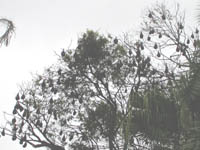 Flying foxes (large fruit bats) asleep in the trees at the Sydney Botanical Gardens.
Flying foxes (large fruit bats) asleep in the trees at the Sydney Botanical Gardens.
 A flying fox overhead
A flying fox overhead
 This is a sulphur-crested cockatoo, feeding on the grass in the Sydney Botanical Gardens.
This is a sulphur-crested cockatoo, feeding on the grass in the Sydney Botanical Gardens.
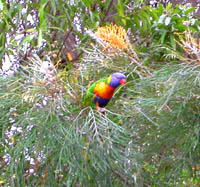 A rainbow lorikeet, a small but extremely colorful parrot. This picture was taken in the Sydney Botanical Gardens.
A rainbow lorikeet, a small but extremely colorful parrot. This picture was taken in the Sydney Botanical Gardens.
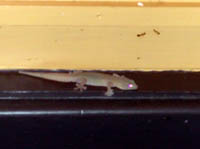 The lodge at Glen Helen had lots of these jewelled geckos that come out at night and feed off the bugs attracted to the lights.
The lodge at Glen Helen had lots of these jewelled geckos that come out at night and feed off the bugs attracted to the lights.
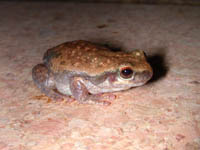 This is a desert treefrog (that's its proper name). He actually lives in the tank behind the toilet out here at the hangar.
This is a desert treefrog (that's its proper name). He actually lives in the tank behind the toilet out here at the hangar.
 This is a picture of a white-rumped miner, a bird that is fairly common around Alice. This was one of two adults who were feeding a very persistent and noisy adolescent at the Alice Springs Telegraph Station.
This is a picture of a white-rumped miner, a bird that is fairly common around Alice. This was one of two adults who were feeding a very persistent and noisy adolescent at the Alice Springs Telegraph Station.
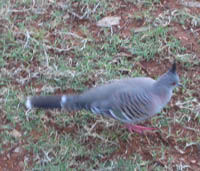 This
bird is a crested pigeon. These birds are related to the U.S. mourning doves, but look a lot sillier with the sharp crest on the top of their heads.
This
bird is a crested pigeon. These birds are related to the U.S. mourning doves, but look a lot sillier with the sharp crest on the top of their heads.

This is a photo of a sparrow-sized moth called a "ghost moth". This is the moth whose larvae are
known as witchetty grubs, a local delicacy.
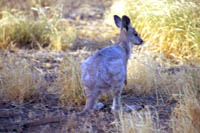 This red kangaroo at the Alice Springs Telegraph Station was obviously quite young, although I didn't see a mother kangaroo around. He was unsure of me, but moving slowly, I was able to get close and get a good picture. Then I backed away and left him alone.
This red kangaroo at the Alice Springs Telegraph Station was obviously quite young, although I didn't see a mother kangaroo around. He was unsure of me, but moving slowly, I was able to get close and get a good picture. Then I backed away and left him alone.
 There were a number of red kangaroo that we saw on the road to Trephina Gorge. This is the first one that we saw, and he decided to take off just as I was focusing my camera on him. I did get a good picture of him jumping, though.
There were a number of red kangaroo that we saw on the road to Trephina Gorge. This is the first one that we saw, and he decided to take off just as I was focusing my camera on him. I did get a good picture of him jumping, though.
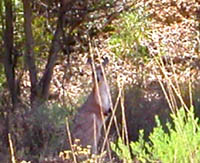 This red kangaroo was one of a pair that were resting in the shade just off the road to Trephina Gorge.
This red kangaroo was one of a pair that were resting in the shade just off the road to Trephina Gorge.
 Bob Hull took this great picture of a red kangaroo at the old Telegraph Station here in Alice Springs.
Bob Hull took this great picture of a red kangaroo at the old Telegraph Station here in Alice Springs.
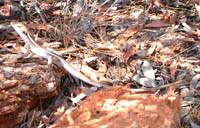 This small lizard (a two-lined dragon) is about the most common type of
lizard around Alice.
This small lizard (a two-lined dragon) is about the most common type of
lizard around Alice.
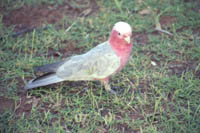 The Telegraph Station had lots of galahs and this one let me get quite close to it (less than 2 meters away).
The Telegraph Station had lots of galahs and this one let me get quite close to it (less than 2 meters away).
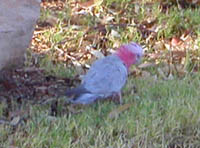 A galah is a type of
parrot very similar to a cockatoo. Exotic to us in the states, but all
over the place here.
A galah is a type of
parrot very similar to a cockatoo. Exotic to us in the states, but all
over the place here.
 Here is a flock
of galah on the ground near my motel. These birds are very common in many
parts of Australia and because the congregate in large, loud, and messy
flocks, they are considered by some to be quite a nuisance. They like
communally waking each other up with loud squawks right at the first sign
of light in the morning
Here is a flock
of galah on the ground near my motel. These birds are very common in many
parts of Australia and because the congregate in large, loud, and messy
flocks, they are considered by some to be quite a nuisance. They like
communally waking each other up with loud squawks right at the first sign
of light in the morning
 The black-footed
wallaby is endangered, but can easily be found at Simpson's Gap near Alice
Springs. They were nervous at first, but when I sat quietly for a few
minutes (it helped that I was the only person around), they became quite
curious. The closest one came to me was about 9 feet, but when I moved to
bring up my camera, he hopped off. These pictures were taken at about 25
- 40 feet with a zoom.
The black-footed
wallaby is endangered, but can easily be found at Simpson's Gap near Alice
Springs. They were nervous at first, but when I sat quietly for a few
minutes (it helped that I was the only person around), they became quite
curious. The closest one came to me was about 9 feet, but when I moved to
bring up my camera, he hopped off. These pictures were taken at about 25
- 40 feet with a zoom.
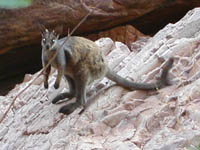 This is a different
wallaby.
This is a different
wallaby.
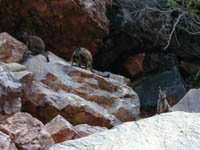 I saw 10 - 12
wallabies total (it was a little hard to make an accurate count), almost
all of them in groups (probably family groups) of 2 - 4 wallabies.
I saw 10 - 12
wallabies total (it was a little hard to make an accurate count), almost
all of them in groups (probably family groups) of 2 - 4 wallabies.
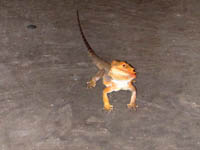 A fairly large (~20
inch) bearded lizard was in the Simpson's Gap Visitor Center, munching
away at the line of ants that were running across the cement.
A fairly large (~20
inch) bearded lizard was in the Simpson's Gap Visitor Center, munching
away at the line of ants that were running across the cement.
 The lizard was quite
calm about me getting close to it, but the flash of my camera finally made
it skitter off into the bushes. I got one more picture of it with a more
natural background.
The lizard was quite
calm about me getting close to it, but the flash of my camera finally made
it skitter off into the bushes. I got one more picture of it with a more
natural background.
 This black kite sailed right over my head at the Telegraph Station and I got a pretty good picture of it.
This black kite sailed right over my head at the Telegraph Station and I got a pretty good picture of it.
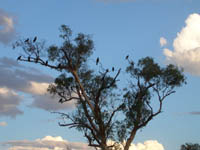 As evening progressed, it seems that most of the black kites in the area come to the Alice Spring Telegraph Station to roost for the night. This is one of several trees that was crowded with these hawks.
As evening progressed, it seems that most of the black kites in the area come to the Alice Spring Telegraph Station to roost for the night. This is one of several trees that was crowded with these hawks.
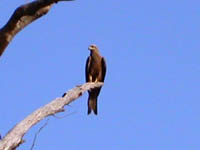 A black kite (also
called a fork-tailed kite) is a type of hawk very common around here.
A black kite (also
called a fork-tailed kite) is a type of hawk very common around here.
Flora
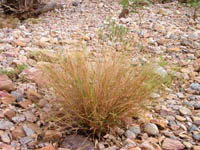 Spinifex grass is one of the most common and most important plants in the Australian Outback.
Many of the animals either use Spinifex as food or as a home, or both. However,
when the hollow cylindrical leaves dry out, they are quite formidable. They can
puncture car tires pretty easily, making cross country travel quite interesting
at times.
Spinifex grass is one of the most common and most important plants in the Australian Outback.
Many of the animals either use Spinifex as food or as a home, or both. However,
when the hollow cylindrical leaves dry out, they are quite formidable. They can
puncture car tires pretty easily, making cross country travel quite interesting
at times.
 Although the Outback is a desert, there are not many plants that we would call
cactuses (except introduced cactuses in people's yards). This small plant I
found at Ellery Creek Big Hole was the closest I found.
Although the Outback is a desert, there are not many plants that we would call
cactuses (except introduced cactuses in people's yards). This small plant I
found at Ellery Creek Big Hole was the closest I found.
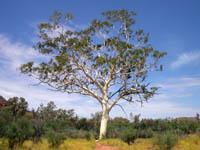 The plaque says that this is the largest ghost gum in the Eastern MacDonnell Mountains. It's a little ways off the road to Trephina Gorge.
The plaque says that this is the largest ghost gum in the Eastern MacDonnell Mountains. It's a little ways off the road to Trephina Gorge.
This file was last modified February 23,
2003